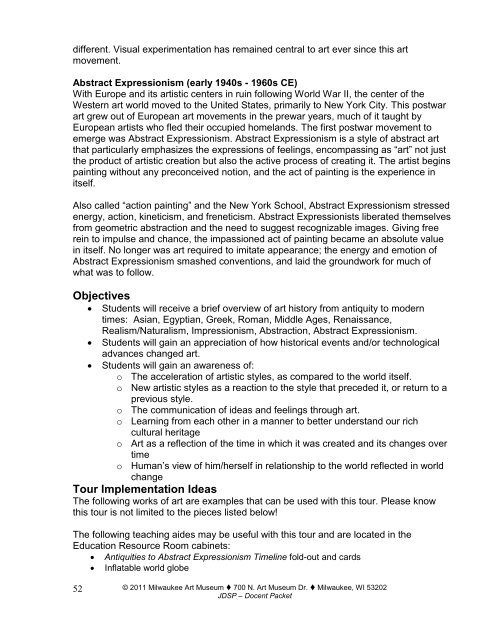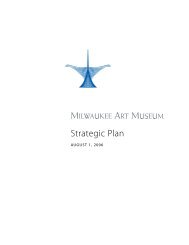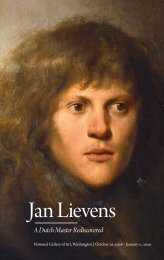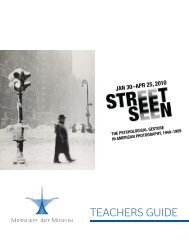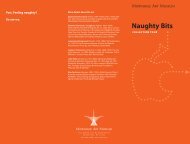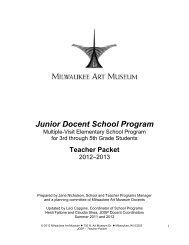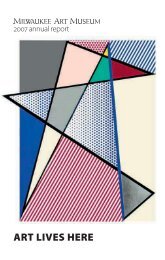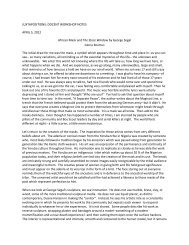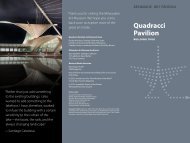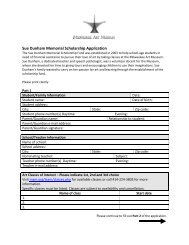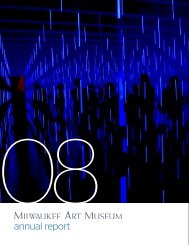Junior Docent School Program - Milwaukee Art Museum
Junior Docent School Program - Milwaukee Art Museum
Junior Docent School Program - Milwaukee Art Museum
You also want an ePaper? Increase the reach of your titles
YUMPU automatically turns print PDFs into web optimized ePapers that Google loves.
different. Visual experimentation has remained central to art ever since this art<br />
movement.<br />
Abstract Expressionism (early 1940s - 1960s CE)<br />
With Europe and its artistic centers in ruin following World War II, the center of the<br />
Western art world moved to the United States, primarily to New York City. This postwar<br />
art grew out of European art movements in the prewar years, much of it taught by<br />
European artists who fled their occupied homelands. The first postwar movement to<br />
emerge was Abstract Expressionism. Abstract Expressionism is a style of abstract art<br />
that particularly emphasizes the expressions of feelings, encompassing as “art” not just<br />
the product of artistic creation but also the active process of creating it. The artist begins<br />
painting without any preconceived notion, and the act of painting is the experience in<br />
itself.<br />
Also called “action painting” and the New York <strong>School</strong>, Abstract Expressionism stressed<br />
energy, action, kineticism, and freneticism. Abstract Expressionists liberated themselves<br />
from geometric abstraction and the need to suggest recognizable images. Giving free<br />
rein to impulse and chance, the impassioned act of painting became an absolute value<br />
in itself. No longer was art required to imitate appearance; the energy and emotion of<br />
Abstract Expressionism smashed conventions, and laid the groundwork for much of<br />
what was to follow.<br />
Objectives<br />
<br />
<br />
<br />
Students will receive a brief overview of art history from antiquity to modern<br />
times: Asian, Egyptian, Greek, Roman, Middle Ages, Renaissance,<br />
Realism/Naturalism, Impressionism, Abstraction, Abstract Expressionism.<br />
Students will gain an appreciation of how historical events and/or technological<br />
advances changed art.<br />
Students will gain an awareness of:<br />
o The acceleration of artistic styles, as compared to the world itself.<br />
o New artistic styles as a reaction to the style that preceded it, or return to a<br />
previous style.<br />
o The communication of ideas and feelings through art.<br />
o Learning from each other in a manner to better understand our rich<br />
cultural heritage<br />
o <strong>Art</strong> as a reflection of the time in which it was created and its changes over<br />
time<br />
o Human‟s view of him/herself in relationship to the world reflected in world<br />
change<br />
Tour Implementation Ideas<br />
The following works of art are examples that can be used with this tour. Please know<br />
this tour is not limited to the pieces listed below!<br />
The following teaching aides may be useful with this tour and are located in the<br />
Education Resource Room cabinets:<br />
Antiquities to Abstract Expressionism Timeline fold-out and cards<br />
Inflatable world globe<br />
52<br />
© 2011 <strong>Milwaukee</strong> <strong>Art</strong> <strong>Museum</strong> 700 N. <strong>Art</strong> <strong>Museum</strong> Dr. <strong>Milwaukee</strong>, WI 53202<br />
JDSP – <strong>Docent</strong> Packet


